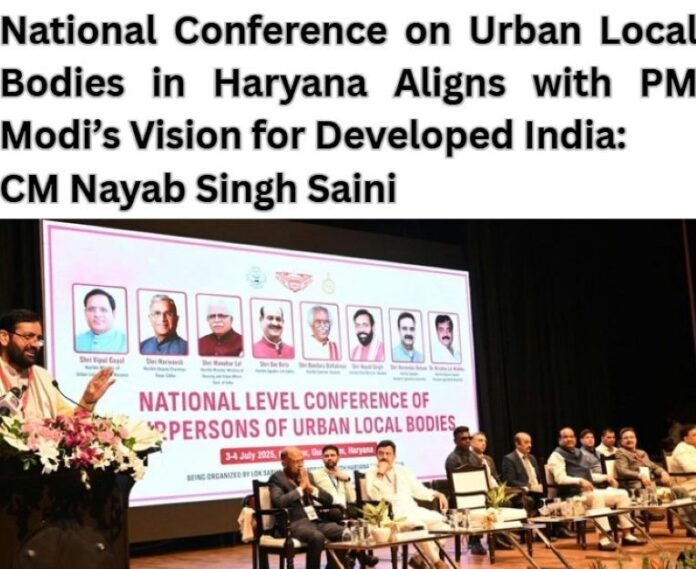In a significant step towards strengthening grassroots democracy and accelerating India’s journey toward the vision of a developed nation by 2047, Haryana Chief Minister Nayab Singh Saini addressed the inaugural National Conference of Urban Local Bodies’ Chairpersons held in Manesar. The event, which brought together urban governance representatives from across the country, was marked by discussions on strengthening urban infrastructure, improving governance transparency, and aligning state and local efforts with Prime Minister Narendra Modi’s vision for a “Viksit Bharat” or Developed India.
Expressing pride that Haryana was chosen to host this landmark gathering, Chief Minister Saini said the conference serves as a collective forum for introspection and policy evolution. He underscored the pivotal role urban local bodies play in shaping India’s democratic and developmental aspirations. According to the Chief Minister, local urban governance is the foundational tier of democracy and forms the nurturing ground for responsible leadership and effective public service. When local governance is empowered, it results in stronger national governance, he added, reinforcing that robust infrastructure and transparent services make citizens feel confident in their elected representatives.
The Chief Minister reiterated Haryana’s commitment to the national development agenda by announcing that the state has set an ambitious target to become a one trillion-dollar economy by 2047. This vision also includes generating 5 million new jobs, emphasizing that the prosperity of Haryana’s urban centers is integral to realizing this goal. To complement this vision, the state is actively planning the development of five ultra-modern cities along the 180-kilometer-long Kundli–Manesar–Palwal (KMP) expressway corridor under the Panchgram initiative. These futuristic urban hubs are designed to accommodate a population of 7.5 million by 2050, with Gurugram serving as a model of what integrated urban development can achieve.
Highlighting the transformative impact of governance driven by public-private partnerships, CM Saini noted that schemes like AMRUT have significantly strengthened the urban infrastructure backbone. With every household in Haryana now equipped with a unique identification linked to government schemes, benefits are reaching citizens at their doorsteps. The Chief Minister pointed out the successful implementation of the Swamitva Yojana and the digital governance initiative ‘Nagar Darshan Portal’, which are helping streamline services, reduce corruption, and bring transparency.
Saini stated that e-governance and AI-driven problem solving are now integral components of municipal operations in Haryana. Be it property tax collection, solid waste management, or electricity billing, every service is being digitalized for efficiency and accountability. He emphasized the need for all urban bodies to develop a Green Action Plan, integrating sustainability at the heart of city planning. Initiatives like rainwater harvesting, green building policies, solar energy promotion, and electric vehicle adoption are being prioritized under the state’s green growth strategy. Programs such as Jal Jeevan Mission and Amrit Sarovar are also being fast-tracked to counter the growing water crisis.
As part of ensuring dignity and welfare for the urban poor, Saini spoke about the massive housing push under PMAY. In Haryana, the state has already constructed 148 dormitory units in Kundli and Manesar industrial zones for migrant laborers. The Chief Minister added that the goal is to create slum-free cities that provide clean water, sanitation, and basic dignity to every citizen. Cleanliness, he remarked, must evolve beyond a mission to become a part of the public’s mindset. From citizen awareness in the first phase of Swachh Bharat to infrastructure creation in the second, the third phase must be about cultural transformation, promoting practices like source segregation, bio-CNG production, and circular economy adoption.
Calling for a nationwide alignment of vision and action, Chief Minister Saini appealed to urban administrators to actively participate in fulfilling the dream of a developed India by 2047. He said Haryana’s urban development roadmap stands as a testament to what collaborative governance and futuristic planning can achieve, and reiterated that the state’s commitment to Prime Minister Modi’s vision remains unwavering.
#UrbanDevelopment #HaryanaNews #ViksitBharat2047 #NayabSinghSaini #PMModiVision #SmartCitiesIndia #UrbanGovernance #IndianEconomy #OneTrillionDollarEconomy #KMPExpressway #PanchgramModel #ManesarConference #EgovernanceIndia #CleanIndia #DigitalUrbanIndia #JalJeevanMission #GreenUrbanPlanning #SwachhBharat #UrbanInfrastructure #DevelopedIndia
This is an auto web-generated news web story.




